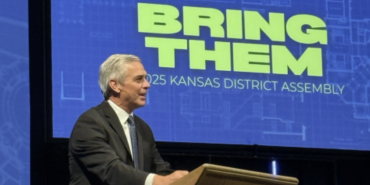Bury Me with My Feet Pointing East

I don’t want much at my demise: a pine box, family and friends gathered at a church, some hymns, some scripture, and a service of Holy Communion. Tell a story or two about me, if you must. But mostly talk about the One who saved, filled, and called me. And when the service is over, follow me to the cemetery, committing my spirit to God as you commit my body to the grave.
Oh, and just one more thing: bury me with my feet pointing east.
It may seem a strange request, especially in a world that has little use for ancient traditions. Most of us don’t know that at one time churches and graveyards were oriented so that the congregation (both living and deceased) faced east, in order to be facing Christ at His return. Even today some cemeteries retain this orientation so that at the resurrection we’ll all be facing in the same direction.
I still remember the first time this was explained to me. It wasn’t in a class on Christian history or worship, nor was it in a book. At one of my first graveside services, the funeral director wanted to make sure I was standing at the head of the casket and made sure I understood why the body was oriented with its feet pointed east. “That’s so we’ll all be facing the same way at the resurrection,” he said. “Otherwise we’d be facing every which way when Jesus returns.”
I nodded and smiled, pretending that I had always known this little tidbit of information. Here’s the embarrassing part: I found it quaint, archaic, unenlightened, and amusing. It was as though the funeral director had told me this quirky, mythical, superstitious belief that nobody really believed anymore.
To be sure, the idea of Christ returning in the east probably is speculation. A single verse, Matthew 24:27, talks about lightning flashing in the east and being visible in the west. This verse is probably where we get the idea of Christ returning in the east.
But my problem was deeper than that. It wasn’t just that I found the location of Christ’s return to be quaint. The truth was that I really hadn’t given much thought to the second coming of Christ. And I certainly hadn’t thought much about the resurrection of the dead.
So here I am, an ordained elder in the Church of the Nazarene, trained by some brilliant religion professors. I consider myself a lifelong learner, fairly well read, and aware of Christian tradition and doctrine. But I hadn’t really given any thought to the resurrection. In fact, when I thought about it, I realized that my belief system sort of stopped at the idea “if you believe in Jesus, then you go to heaven when you die.”
I suspect that I am not alone. It has increasingly become evident to me that modern-day, evangelical Christians aren’t really sure what to do with the doctrine of the resurrection. Our poems, eulogies, and even many of our hymns fall short of proclaiming this central Christian truth.
We’ve built so much of our teaching around the importance of “going to heaven when we die,” that we have often relegated the doctrine of the resurrection to obscurity.
Yet, this is an important teaching of the New Testament. According to Paul, “The trumpet will sound, the dead will be raised imperishable, and we will be changed,” (1 Corinthians 15:52b). In Romans 6:5 we are reminded, “If we have been united with him in his death, we will certainly also be united with him in his resurrection.” In Philippians 3:11, Paul looks forward to “attaining to the resurrection from the dead,” and in 1 Thessalonians 4:16 we are taught, “The “dead in Christ will rise first.”
Philippians 3:21 tells us that Jesus “will transform our lowly bodies so that they will be like his glorious body.” From the gospel accounts of the resurrected Jesus, we know that His resurrected body was similar and yet different. It was recognizable, it was touchable, it took food and drink. At the same time, it could pass through locked doors and suddenly appear and disappear. Perhaps this is a glimpse of eternity, not ethereal spirits floating around on clouds, but recognizable bodies inhabiting the new heavens and the new earth.
Even the ancient creeds affirm the centrality of the resurrection of the body, indicating that the early church held this doctrine in high regard. It is for that reason that they buried their dead with their feet to the east—a simple affirmation of faith in the resurrection of the dead.
This is why I want to be buried with my feet pointing east. It’s not because I’m confident that Christ will return in the east. Nor do I think it ultimately matters; Christ can resurrect us whether we are facing east, west, north, or south. Christ can certainly resurrect those who were cremated, those who were in natural disasters, and those who were lost at sea. I want to be buried with my feet pointing east as an affirmation of faith, a simple act that reminds those gathered around my casket that we believe in the resurrection of the dead.
In doing so, we look forward to the picture painted in Revelation: a redeemed and renewed creation, the Temple of God coming down out of heaven to the New Jerusalem, a restored Garden of Eden with a Tree of Life. It is a picture of the future, of how God intended the world to be, of a time when all will be made right.
In that kingdom:
The blind will see.
The mute will shout.
The lame will leap for joy.
Death will be swallowed up forever.
The wolf will live with the lamb.
The leopard will lie down with the goat.
Those who are part of the kingdom of heaven will be resurrected and given new bodies like Jesus’ glorious body. Our transformation will be complete, and we will fully be the people of God for all of eternity.
Maranatha!
Jon Twitchell is pastor at the Church of the Nazarene in Cape Elizabeth, Maine, a funeral home chaplain, and the author of Presence: A Pastor Jamie Guide to Funerals.
Please note: All facts, figures, and titles were accurate to the best of our knowledge at the time of original publication but may have since changed.




